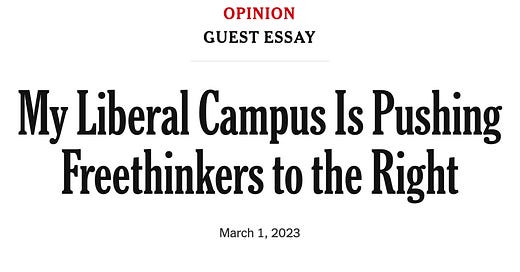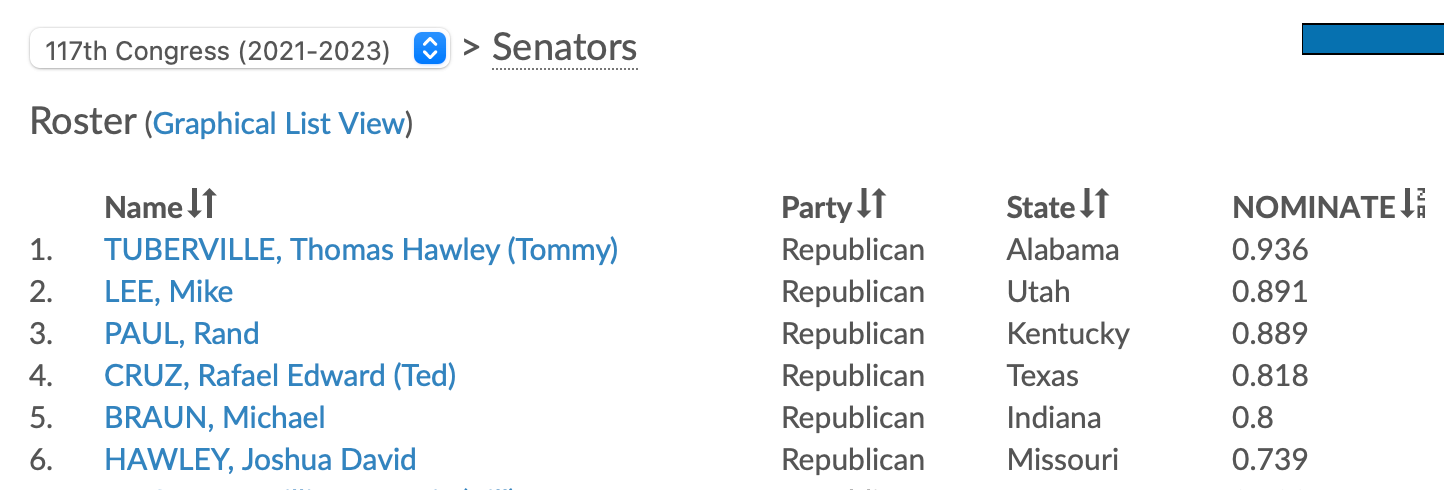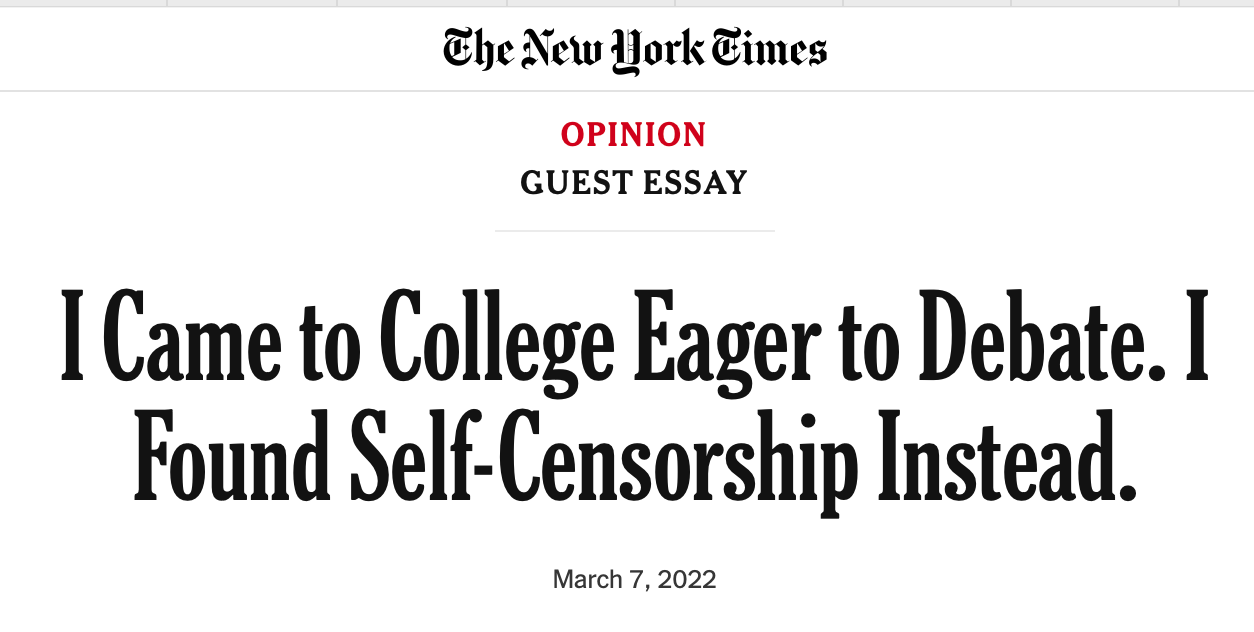A New York Times guest essay exposes the Times' own biases
Why is the world's most prestigious opinion section mimicking a subpar right-wing college newspaper?
It’s time once again to ask: Why does this New York Times column exist?
The New York Times identifies the author of the piece only as “Adam S. Hoffman” and “Mr. Hoffman is a senior at Princeton.” (Not the first time such thin credentials have landed a right-wing college student a coveted spot in the Times, but we’ll get to that later.) In fact, Mr. Hoffman is the publisher of a right-wing campus publication1 at Princeton and has served as Chairman of the Princeton College Republicans, co-chair of the New Jersey College Republicans, president of Princeton’s conservative debate society, and chair of High School Republicans of Texas. A press release announcing Hoffman as co-chair of “Teens for Ted Cruz” in 2015 described Hoffman as “a staple in Texas politics” whose “years in the political arena” included working for Greg Abbott and interning for Ted Cruz. In short, Hoffman is a committed Republican activist and has been since high school, a fact the New York Times withheld from its readers.
Hoffman’s partisan political activity is not insignificant information; it is essential to assessing the credibility of his essay. It makes clear that Hoffman is not a disinterested observer offering a dispassionate analysis but rather a partisan decrying the alleged extremism of his ideological opponents. “My opponents are bad” is exactly the kind of self-serving argument newspaper opinion editors often roll their eyes at.2 Times readers might have, too — if the Times hadn’t helped Hoffman hide his partisanship.
As for the essay itself, it’s terrible. Here, take a look at the closing paragraph:
Mr. Trump and Ron DeSantis are different kinds of politicians from John McCain and Mitt Romney. To be sure, top universities have produced outspoken conservatives like Ted Cruz and Josh Hawley. But now formative years at elite institutions that have gone woke are convincing right-leaning students and heterodox thinkers that society’s most august institutions — from media outlets to universities — are fundamentally broken and need to be set on a different path. If colleges don’t want to produce a new generation of conservative firebrands, they need to pump the brakes on campus progressivism. Campuses that are more welcoming to conservatives are in universities’ own interest.
What … what does this paragraph even mean? What do the six politicians mentioned in the first half of the paragraph have to do with the second half? How do they relate to each other, in the author’s mind? How do Cruz and Hawley fit into the Trump/DeSantis to McCain/Romney spectrum established in the first sentence? How do they relate to the “conservative firebrands” referenced later in the paragraph? I have no idea. The author doesn’t spell any of this out. My best guess is that the first sentence is pure throwaway, completely irrelevant and unnecessary to the rest of the paragraph, and Cruz and Hawley represent (according to the author) the kind of non-firebrand conservatives at risk of dying out as (again, according to the author) campus progressives inspire young would-be-Cruzes to instead become “firebrands.” But I’m just guessing here; the paragraph is a mess. And if that is what the paragraph is supposed to mean, it’s worth noting that the implication that Cruz and Hawley aren’t “conservative firebrands” is a reflection of the author’s own far-right leanings: Cruz and Hawley were both among the six most-conservative Senators in the last congress.
Not to mention the time Josh Hawley gave the January 6 crowd a raised-fist salute shortly before the insurrection began:


So anyway, it’s a really badly-written3 piece written by an (undisclosed) partisan with an (undisclosed) axe to grind. But wait: There’s plenty more to dislike.
Hoffman’s argument is that “In the not-so-distant past” college Republicans were good-natured, moderate chaps who “idolized Ronald Reagan” and whose ideas were “respectfully challenged” on their liberal campuses — but today, campus conservatives “tend toward scorched-earth politics” as a “result of puritanically progressive campuses” that “have become breeding grounds for conservative firebrands.” All of this, college student Hoffman tells us, has taken place in the last eight years:
The story of this transformation, according to the social psychologist Jonathan Haidt, starts around 2014, when Gen Z arrived on campus. The new progressive students were less tolerant of heterodox ideas and individuals. Demands to rescind invitations to speakers seemed to spike. The terms “microaggression” and “trigger warning” made it into everyday campus parlance. At Yale, for instance, a lecturer’s suggestion that students should determine which Halloween costumes are acceptable for themselves ignited a firestorm.
These changes were felt on my campus, too. “Princeton has become a much more politicized place over the last 10 years,” said Thomas Kelly, a philosophy professor. It’s also become more progressive. Diversity training sessions blatantly endorse progressive ideas: Espousing a colorblind ideal, for example, is deemed a “microinvalidation.” Bureaucrats police conduct and speech. Many programs cater to left-wing causes.4
For readers who are a bit older than the typical college senior (or perhaps just more knowledgable of recent history than this particular college senior) this is all immediately recognizable as precisely the same line conservatives were peddling about “political correctness” in the 1980s and 1990s. That’s the precise era Hoffman portrays as a golden age of campus inter-ideological bonhomie. If we assume Hoffman is writing in good faith,5 he clearly lacks the perspective and knowledge of recent history the New York Times should require of the author of a guest essay on this topic.6
And what are the consequences of all this alleged campus oppression of conservatives? Hoffman says he’s “been told” that in the past at Princeton “politics were mostly separable from personal relationships.” But today, he complains, “a student who jokes about the wrong subject might face social punishment” — again, right out of a 1994 David Spade movie. Hoffman doesn’t elaborate on what the “wrong subject” is or what “social punishment” means, but it’s pretty clear: He’s upset that some people won’t be friends with him if he’s a bigot. He isn’t being denied the right to hold or express right-wing views; he’s mad that people can choose not to associate with him as a result. Unlike the golden era at Princeton where you could apparently tell a racist joke and remain the life of the party. (According to Hoffman, even back then universities “skewed liberal,” which … perhaps they did not, if there was widespread social acceptance of racist and sexist jokes. Just a thought!)
I saved the best part for last:
Sometimes young conservative agitators are dismissed, cynically, as attention seekers or opportunists. But in my experience, the negative consequences of conservative activism on campus, both personal and professional, far outweigh any benefit that they might incur.
Here I will remind you that Adam Hoffman, while still in college, is writing these words for the world’s most prestigious and influential opinion section. That despite the lousy writing and poor grasp of recent history, the New York Times has given an undergraduate political operative a guest-essay to take potshots at his political opponents, and helped him obscure his own biases and incentives. That in addition to the Times, Hoffman has been published by Newsweek and National Review (as a sophomore) — solely because he is a conservative. Hoffman isn’t facing “negative consequences” of being a campus conservative — he’s reaping the rewards of it. There are few things the New York Times likes better than giving highly coveted op-ed space to conservative college students complaining about how tough they have it. Almost exactly a year ago, the Times ran a similar piece by a then-UVA senior who is now an assistant editor at Reason:
So, why does this latest New York Times guest essay exist? It’s a badly-written and myopic complaint by a college student who claims to be oppressed even while he’s being handed the a byline in the world’s most prestigious news outlet; it recycles not only his own previously-published complaints but those the Times has previously published; and it is the kind of dog-bites-man attack by a partisan on his political opponents that rarely gets a second look from editors.
It has essentially nothing going for it.
Except this: It tells a story the New York Times wants to tell about oppressive liberals and heroic, intellectually brave conservatives. That’s story the New York Times keeps telling, over and over, as if desperate to speak a backlash against liberalism into existence. It exists because a Princeton college student understood that the New York Times has absolutely no standards when it comes to peddling this story, or to publishing and promoting right-wingers.
And that’s why this is important. Not because of what it says about Princeton or college campuses in general (very little.) Because of what it illustrates about the New York Times.
Bizarrely, the Times allowed Hoffman to reference the publication and pieces it published without noting he is its publisher and former editor-in-chief.
Recall that when the Times ran a guest essay bashing liberals for supposedly exaggerating the danger of Ron DeSantis, it got around this problem by dubiously presenting the essay as a critique from a fellow liberal. Even the Times couldn’t claim Hoffman is a liberal, so instead they simply hoped nobody would notice he’s a conservative activist.
And a really badly-edited piece.
If you click on the link on the word “many” — I don’t recommend it — you’ll find that Hoffman has linked to an opinion piece he wrote for Newsweek in which he claims “Princeton effectively barred me from hosting a conservative speaker on campus.” Click through that link and you’ll get to an article in Hoffman’s right-wing college publication about an event Hoffman hosted for the author of Irreversible Damage: The Transgender Craze Seducing Our Daughters. At that event, according to the Tory, Hoffman favorably compared the book to speaking out against Nazis in 1930s Europe. This is exhausting.
To be clear, I make no such assumptions. The essay instead appears to be a straightforward example of a partisan activist peddling a self-serving criticism of his ideological and partisan opponents.
Nor does it occur to Hoffman that, to the extent Princeton conservatives have moved to the right since 2014, it’s probably less a result of hearing the term “microagression” and more a result of the same factors that have radicalized non-Princeton conservatives, particularly the multi-billion-dollar right-wing media & political echo chamber.






At an absolute minimum – with an emphasis on those two words – this piece should have more fully and accurately reflected Adam S. Hoffman's affiliations. As Jamison suggests, "is a senior at Princeton" elides everything important about Hoffman's background.
Providing a sufficiently useful accounting of a guest author's affiliation(s) and other key background info, so a reader can understand where they're "coming from" and more competently assess their arguments and facts, should be a standard expectation for any publication. In any realm, general interest or specialized. And regardless of whether that guest author has submitted an opinion piece or something more concrete, such as a discussion of technical alternatives.
Why should this be even slightly controversial?
Great piece, Jamison!
If we're looking for a larger inciting factor for conservatives becoming less milquetoast since 2014 and bigger firebrands, surely the arrival of Trump on the scene, and their wholesale embrace of him is more likely than the arrival of Gen Z on college campuses. It's surely more probably that the never Trump Republicans of 2015, like Sens Graham, Cruz, and Vance who have now fully embraced Trumpism and Trumpist behavior were far more influenced by him and their voters than whatever liberal college kids were saying.